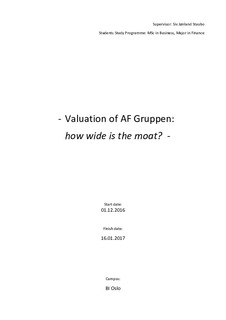| dc.contributor.author | Simenstad, Markus Kristoffer | |
| dc.contributor.author | Johnsen, Eirik Skaare | |
| dc.date.accessioned | 2018-01-10T09:10:51Z | |
| dc.date.available | 2018-01-10T09:10:51Z | |
| dc.date.issued | 2017 | |
| dc.identifier.uri | http://hdl.handle.net/11250/2476584 | |
| dc.description | Masteroppgave(MSc) in Master of Science in Business, Finance - Handelshøyskolen BI, 2017 | nb_NO |
| dc.description.abstract | Economic moats represent sustainable competitive advantages that allow
companies to protect their value and lead to excess returns over a long-term horizon
(Morningstar, 2016). This sentence lays the fundament for this thesis in a way that
we will elaborate on the subject of economic moats; what it is, how it’s obtained
and how it’s valued. Legendary investor Warren Buffett and CEO of Berkshire
Hathaway once said the following:
“The most important thing to me (when considering an investment) is
figuring out how big a moat there is around the business. What I love, of
course, is a big castle and a big moat with piranhas and crocodiles.” –
(Buffet, 1994).
The subject has to some extent been discussed in other literature and whether or not
an economic moat creates excess return has been tested empirically, to be discussed
later on. However, we wish to put the matter into context by performing a case
study on AF Gruppen, where we will perform a fully-fledged valuation of the
company and attempt to value their suspected moat using the frameworks and
theories soon to be introduced. | nb_NO |
| dc.language.iso | eng | nb_NO |
| dc.publisher | BI Norwegian Business School | nb_NO |
| dc.subject | Business | nb_NO |
| dc.subject | Finance | nb_NO |
| dc.title | AF gruppen - valuation and case study on economic moats | nb_NO |
| dc.type | Master thesis | nb_NO |

